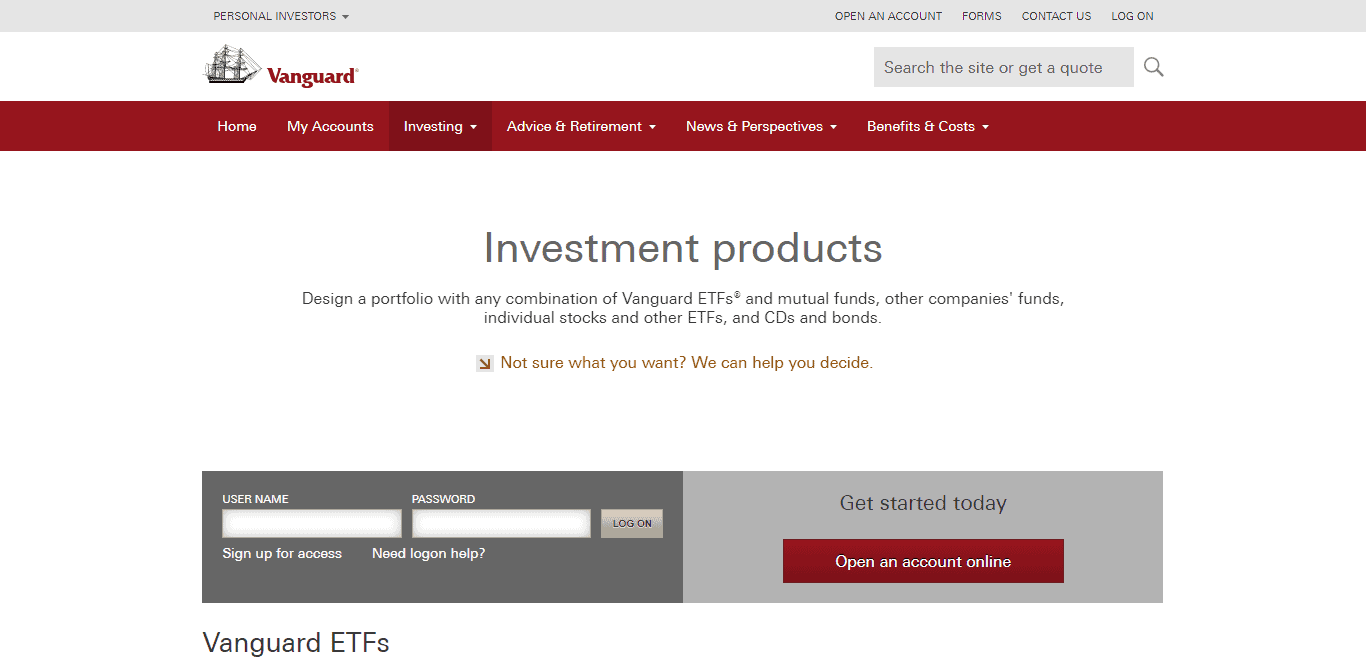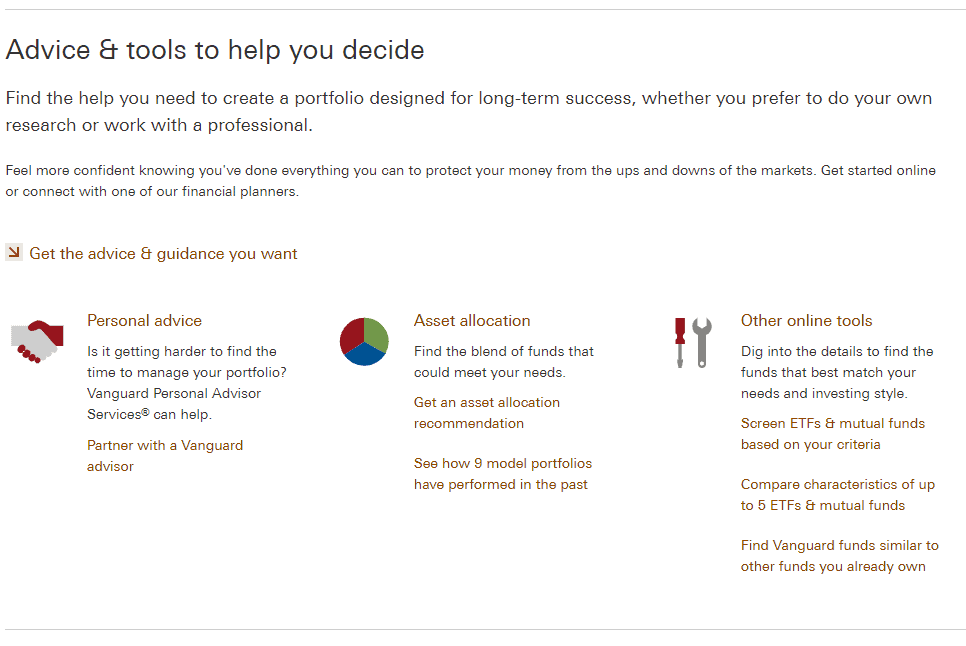- Wells Fargo vs Bank of America: Which is the Better Bank? - November 9, 2019
- M1 Finance and Betterment: A Complete Comparison - November 4, 2019
- Personal Capital vs Wealthfront: Which Should You Go For? - October 20, 2019
There’s no time like the present to start managing our money and taking control of our financial future and building a portfolio. Wealthfront and Vanguard are two Robo-investors that can help you get started.
Before we delve into the meat and potatoes of this post, let’s briefly explore the critical differences between Wealthfront and Vanguard:
Main Differences Between Wealthfront vs Vanguard
The Main Differences Between Wealthfront vs Vanguard are:
- Wealthfront is a lot newer company founded in 2008, whereas Vanguard is an old company that was founded in 1975.
- Wealthfront is fully automated and utilizes a Robo advisor, whereas Vanguard is based on letting you speak to a human advisor which also means that it comes at an extra fee and according to them it’s of the main features that sets the software apart from its competitors.
- Wealthfront offers direct indexing to its customers, which can be useful to those with portfolios over $100, whereas Vanguard doesn’t
- Wealthfront is considered the more affordable option of the two, whereas Vanguard is the more expensive one because it charges an annual fee of $20 as well as varying percentages on different accounts (customers need to watch their portfolio and stay engaged to ensure they don’t face unexpected fees)
- Wealthfront’s portfolios for each client are based on automated analytics, whereas Vanguard’s portfolios are individually put together for each investor by a financial advisor.
- Wealthfront minimum requirements for accounts to enter are much lower and you can start with $500, whereas Vanguard requires at least $50,000
Why Use Robo Investors?
Robo investment is a low-cost and easy to use way to invest digitally. This eradicates a lot of the hard work traditionally associated with investments. Needless to say, this makes this field far more accessible. Robo Investors build a portfolio for you at the click of a few buttons, and they’ll maintain your account.
It’s an easy, convenient way to invest and preserve your time from the comfort of your own home. Since a portfolio is recommended for you, you can start investing without knowing much about the market. It’s an easy way for both the ‘everyday kind of guy’ and big financial gurus to kickstart their investments.
If you want an investment portfolio to earn or save a bit of cash on the side, it might be a good time to look at the different Robo investors. There are a few on the marketer. But, in this article, we’re going to look at the two leading Robo advisors – Wealthfront and Vanguard.
Both are software platforms that allow you to manage your money, investments, and have greater control over your overall finances. Vanguard and Wealthfront are popular choices and well-reviewed, so we’re going to take a look at both to help you make the right choice for your future.
Who’s Wealthfront?
Founded in 2011 by former trader Dan Carroll and Andy Rachleff, who also co-founded VC Benchmark Capital. They wanted to provide software that makes “investing easier and better for more people.”
Both felt that since the 2008 financial crash, and before that, too, most people didn’t have access to decent financial advice. And, even if they did, they were charged a hefty price tag by the financial advisors. They say: “we’re here because more people across the economic spectrum deserve to live secure and rewarding lives.”
Someone must agree with them. Based in Redwood City, California, they currently manage more than $20 billion in assets via Wealthfront.
The company has created software that can manage finances 24/7 and will monitor them too. They believe that “technology can handle some things better than people.”

Wealthfront: The Basics
Wealthfront is aimed at millennials who are just starting out, including college students. However, they do also invest on behalf of high yield individuals too. Here’s some of what they offer:
- You can open an account with just $500.
- The account management fee is 0.25%
- The Exchange Traded Fund (ETF) expense ratios average at 0.08%
- There are no account fees, not for opening, transfers or closing, or annual fees.
- It supports individual and joint non-retirement accounts, 529 college savings plans, cash accounts, trusts and traditional, Roth, SEP, and rollover IRAs.
- The 529 college savings account is unusual for Robo-advisors. Fees are a bit higher for these and include an administrative fee too.
- They carry out tax-loss harvesting on taxable accounts daily. They also conduct stock level tax-loss harvesting on accounts over $100,000, smart beta on $500,000 + balances. TurboTax customers can import tax-loss harvesting data from Wealthfront.
- It’s all automated. There are no humans to talk to
- Free financial planning tools even if you don’t have a Wealthfront account
- You can link your outside accounts
- Line of credit
- Phone support Monday-Friday 11 am to 8 pm (Eastern time)
- Wealthfront cash account gives you 2.07% APY with no fees, FDIC insurance up to $1m and unlimited transfers
- Portfolio line of credit when you have $25,000 or more in your investment, individual, or trust account. You can borrow up to 30% of your account.

Who’s Vanguard?
It’s been around a lot longer than Wealthfront, in fact since 1975. They are partly automated, and although they didn’t always offer digital or Robo-investing, they do now. They have offices all around the world, from Amsterdam, Holland to Zurich and Switzerland, although their corporate HQ is in Pennsylvania. They are investment owned. This means that it is owned literally by its funds, which are owned by their shareholders, aka, their account holders.
Their total assets run at around $5.2 trillion globally, as of January 2019. They run about 190 funds in the US and a further 220 around the world, with more than 30 million investors in around 170 countries. They aim to “take a stand for all investors, to treat them fairly, and to give them the best chance for investment success.”
They’re big on building up their “crew” as they like to call them, as well as putting a face to a name. In fact, there’s an entire section on their website dedicated to precisely that. Anyone thinking of investing can hear why they should from the mouths of the Vanguard “crew.”
The Vanguard Basics
- You get to work with a live human being
- The account minimum is $50,000
- Account management fees depend on the balance:
- 0.05% on balances of $25m +
- 0.10% on balances between $10m and less than $25m
- 0.20% on balances between $5m and less than $10m
- 0.30% on balances less than $5m.
- The expenses investment ratio ranges between 0.04% to 0.12%, with an average of 0.08%
- There are no account fees
- Portfolios are created by advisors for each individual.
- They support non-retirement accounts, Trusts, and SEP, rollover, traditional and Roth IRAs.
- Their tax strategy is to allocate their assets among tax-advantaged and taxable accounts. They do tax-loss harvesting on a client-by-client basis.
- There are phone and email customer support, Monday to Friday, 8 am to 8 pm, Eastern time
- Human Advisor appointments are available as above.

So, now we’ve provided a general overview of both, let’s get down to the nitty-gritty of this comparison.
How to Invest with Wealthfront
It’s quick to open an account, and it’s pretty straightforward, but you have to be 18 or over and a US citizen. Clients can open more than one account. For example, if you want a college fund and a retirement fund, you can do that. It’s a simple way of putting money aside for different life stages without it all sitting in one confusing pot. Doing this also makes it easier to access your money.
Once your account is open, Wealthfront will give you a risk score. They ask you questions and assess how risk-averse you are as well as looking at what your goals are. If someone is new to investing and financial planning, it’s a useful and easy way of ascertaining where they lie in terms of their attitude to money. It’s also especially important if you’re starting out with a modest balance and are fearful of losing any of it or of it not growing/stagnating,
Once your account is open, you have access to your investment plans and your balances. You can monitor these 24/7 and access info about how your money is being managed and how well it’s doing.
Here are some of the main perks of using Wealthfront:
- The minimum accounts to enter are much lower than they are with Vanguard. You only need $500 to get started. Whereas, you need $50,000 with Vanguard. As a result, Wealthfront is much more accessible if you’re just starting out and trying to grow a portfolio from very little to start with.
- It’s easy to diversify accounts. This is great for new investors nervous about investing their funds, as you won’t have to put too many eggs in one basket.
- The fully automated service means you can monitor your accounts 24/7 without having to hire an advisor. Relying on the expert service can save you massive fees!
- Wealthfront is the only Robo investment software that offers direct indexing for account holders with more than $100. This is great if you want more control over your individual stocks and make use of tax-free harvesting.
- Wealthfront is run by educated financial market leaders and designed by data scientists for an easy to use experience catering to the precise needs of investors. The software is intuitive and easy-to-use, making it a great entry platform for new investors.
- Wealthfront promotes free management on the first $5,000 invested and another $5,000 for you and a friend if you refer the service to someone else.
- Free financial planning tools, even if you don’t have a Wealthfront account.

How to Invest with Vanguard
If you have the minimum account balance they are asking for, choose your account and plan. Again, you can split your accounts and separate them out to save for retirement, an IRA, a college fund, or a rollover 401(k).
You apply online, and again it’s quick. You’ll need all the information about where you work and your bank accounts before proceeding. There are quite a few questions you will need to answer, such as your age, risk tolerance, retirement age, and experience of the financial market. All this information isn’t for nothing. It’s used to create Vanguard’s proposed portfolio for you.
After that, you get to choose your investments, funds, and add your money to each account. You can either customize your own finances or choose the automated Robo option. However, you do speak to an advisor too, this is particularly important if you’re entirely new to investing, but have access to more substantial sums of money.
You get to agree on your plan with an advisor and then are asked to do so again a few weeks later once all the paperwork and admin are complete. It gives you the time to really consider your decisions and kind of acts like a cooling-off period before you get to invest.
This is what makes Vanguard stand out:
- You get access to human advisors. This is a massive pro for investors, as it provides personal contact and the help they need to make educated decisions from the get-go. This drastically reduces the likelihood of making costly mistakes. It also makes Vanguard suitable for comprehensive financial planning.
- You can invest via mobile with a check, quickly adding to existing accounts
- Easy access and overview of financial news, stocks, funds, and ETFs
- Ability to sell, buy or exchange your investments
- Available service for automatic rebalancing

Which One Should You Choose?
In the end, deciding on a Robo advisor for your investments is a personal decision. You need to weigh up your needs and compare the fees and advantages of both solutions. Only then can you decide which benefits matter to you most. As considerable amounts of money might be involved, this is a decision that needs a lot of thought and can’t be rushed or summarized in one blog post.
We can, however, make a few general statements on which software can suit which type of investor. Before you take a look at that, however, take some time to reassess your risk tolerance to educate your decision.
Why Think About Risk Tolerance?
Both investment platforms will be asking you questions to determine your risk tolerance in the signup process. This helps them generate a portfolio to you that matches your intentions, whether you are risk-averse or financially aggressive. Knowing beforehand which strategy you are willing to employ can help you make a decision when it comes to your choice of Robo-investors.
If you take a conservative approach to risk tolerance, you won’t want to risk losing too much money on any investment. As such, you’ll play it safe, so you’re not left stranded (financially) if anything goes wrong. You may even be unlikely to place significant investments altogether.
If you’re moderately risk-tolerant, you might desire the majority of your accounts to focus on safe assets — the kinds that are less likely to fluctuate. But, at the same time, you may also place a few larger investments in higher-risk-higher-reward type stocks.
If you are financially aggressive, you might instead be willing to lose a more significant part of the money you invested in the search for a greater reward. You might not be afraid of losing your money and more willing to invest in stocks with greater fluctuation and higher potential.
The questionnaires used by these financial services determine your risk tolerance. But these may be biased towards their services. So, it’s a good idea to be aware of your tendencies and desires when it comes to handling your money. Understand your risk-tolerance before committing to either of these Robo advisors. Once you’ve done that, keep this at the forefront of your mind as you continue reading…

Choose Wealthfront If…
You’re a new investor with little starting funds or interested in 529 college investment plans. You want to enter the world of investment in a relatively safe way without placing too high a risk in any particular account. You require easy to use software that is intuitive to use and makes it easy for you to monitor your accounts at a glance.
Wealthfront offers promotions that help when you’re first starting out. So, if you’re looking into this venture with a friend, the refer-a-friend offer might make Wealthfront an excellent option for you.
Choose Wealthfront if, overall, you’re looking for a more affordable investment option. Or, if you’re a conservative investor looking to take on less financial risk. Wealthfront is ideal if you’re looking for support with smaller, safer investments in a diversified portfolio.

Choose Vanguard If…
You’re looking to make more substantial investments and have a more sizable sum of money to allocate to your accounts from the get-go. Vanguard is better suited to those wanting to commit to longer-term financial planning. Access to financial advisors is relatively low cost and ensures you get the details you need to make informed investment decisions. You won’t be alone in the process, and as you are handling considerably larger funds, this is a great asset to consider.
This makes Vanguard a better asset for moderately or more aggressively tolerant investors that are willing to place larger investments for a greater reward. If that’s your intention, working directly with a financial advisor to create a tailored financial plan, is well worth the little extra cost.
There’s access to tax-loss harvesting on a client by client basis, too. So, while this may not be for you, the option is still there if you need it.
There are no promotions offered at Vanguard, so if you enter into their program, all funds must come from you. It’s overall the bigger investment platform and accompanied by higher costs. So, if you’re joining Vanguard, you’re probably in it to make more significant transactions and set longer-term goals.
Frequently Asked Questions
Even though Robo advisors are a good option for both beginner and advanced investors because they offer low fees and ease of use they can certainly lose you money. Most of Robo-advisor platforms came after the financial crisis so there is no record on how they will perform in a market that lasts longer than expected and if that market falls a few years in a row, there’s a big chance you will lose money.
Whether you hire a professional financial advisor or you are appointed one with the platform it is definitely going to be the better choice compared to Robo advising but that also comes at a cost. The more human contact, the more the cost.
According to Vanguard their Vanguard Explorer (VEXPX) fund is recommended for aggressive investments.

Are You Ready to Start Investing?
We hope this article sheds light on the benefits both these market-leading Robo-investors provide. Better yet, you probably have a better idea of where to best place your money if you’re looking to start investing from the comfort of your own home.
If you’re just starting out, have limited funds, and want to play it safe, we recommend looking at Wealthfront’s free financial planning tools. Then, maybe start with a small but diversified portfolio?
But, if you’re looking to make better use of a considerable sum of money and you can confidently navigate through the financial world, give Vanguard a try. As we’ve already said, this is ideal for investors wanting to plan longer term.
Either way, the decision should be well thought out and based on your own level of risk tolerance and long term personal and financial goals. We hope your research will lead you to the right investment opportunity.
Have you used either Wealthfront or Vanguard before? If so, we’d love to hear how you found them in the comments box below. Let’s get this conversation started!
Further Research
If you enjoyed this comparison we have also prepared an article where we analyze Personal Capital vs Wealthfront that you might enjoy.




